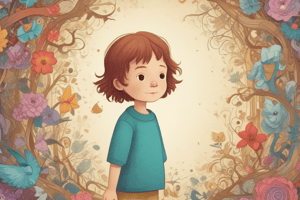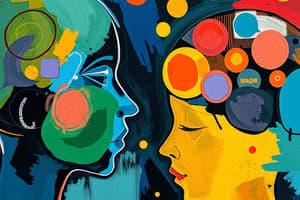Podcast
Questions and Answers
What are the three stages of childhood?
What are the three stages of childhood?
- Early childhood, middle childhood, and late childhood (preadolescence) (correct)
- Infancy, childhood, and adolescence
- Toddlerhood, preschool, and adolescence
- Early childhood, middle childhood, and adolescence
Which theory of child development emphasizes the importance of close emotional bonds between infants and their primary caregivers?
Which theory of child development emphasizes the importance of close emotional bonds between infants and their primary caregivers?
- Vygotsky's sociocultural theory
- Piaget's cognitive development theory
- Attachment theory (correct)
- Ecological systems theory
What is the name of the evolutionary theory in child development that proposes that infants begin life with innate, special-purpose knowledge systems?
What is the name of the evolutionary theory in child development that proposes that infants begin life with innate, special-purpose knowledge systems?
- Core knowledge perspective (correct)
- Behavioral model of development
- Piaget's cognitive development theory
- Ecological systems theory
What is the name of the theory that includes the zone of proximal development and scaffolding to help children learn new tasks?
What is the name of the theory that includes the zone of proximal development and scaffolding to help children learn new tasks?
What are the four stages of Piaget's cognitive development theory?
What are the four stages of Piaget's cognitive development theory?
What are the four subcomponents of language development that combine to form the components of language, sociolinguistics, and literacy?
What are the four subcomponents of language development that combine to form the components of language, sociolinguistics, and literacy?
What is the name of the subcomponent of language development that involves the attachment of meaning to words?
What is the name of the subcomponent of language development that involves the attachment of meaning to words?
What is the name of the theory that proposes that language acquisition is the result of practice and learning?
What is the name of the theory that proposes that language acquisition is the result of practice and learning?
What is the name of the developmental period that occurs between infancy and preschool age?
What is the name of the developmental period that occurs between infancy and preschool age?
Flashcards
Child Development
Child Development
The period from birth to adolescence, marked by significant biological, psychological, and emotional changes.
Attachment Theory
Attachment Theory
A theory that emphasizes the importance of close emotional bonds between infants and their primary caregivers for healthy social and emotional growth.
Brain Plasticity
Brain Plasticity
The ability of the brain to change and adapt in response to experience.
Emotional Intelligence
Emotional Intelligence
Signup and view all the flashcards
Motor Development Stages
Motor Development Stages
Signup and view all the flashcards
Piaget's Cognitive Development Stages
Piaget's Cognitive Development Stages
Signup and view all the flashcards
Zone of Proximal Development
Zone of Proximal Development
Signup and view all the flashcards
Language Development Components
Language Development Components
Signup and view all the flashcards
Longitudinal Studies
Longitudinal Studies
Signup and view all the flashcards
Study Notes
Developmental Change in Children: Key Points
-
Childhood is divided into 3 stages: early childhood, middle childhood, and late childhood (preadolescence).
-
Child development involves biological, psychological, and emotional changes that occur between birth and adolescence.
-
Development may occur due to genetics, environmental factors, or an interaction between the two.
-
Some age-related development periods and examples of defined intervals include: newborn, infant, toddler, preschooler, school-aged child, adolescent.
-
Promoting child development through parental training and quality of care is important.
-
The optimal development of children is considered vital to society.
-
Theories of child development include ecological systems, Piaget's cognitive development, Vygotsky's sociocultural theory, attachment theory, and Erik Erikson's psychosocial stages.
-
Piaget's cognitive development theory includes four stages: sensorymotor, preoperational, concrete, and formal.
-
Vygotsky's sociocultural theory includes the zone of proximal development and scaffolding to help children learn new tasks.
-
Attachment theory emphasizes the importance of close emotional bonds between infants and their primary caregivers for normal social and emotional development.
-
The behavioral model of development focuses on observable and measurable behavior.
-
The "core knowledge perspective" is an evolutionary theory in child development that proposes "infants begin life with innate, special-purpose knowledge systems referred to as core domains of thought."
-
Developmental changes can be continuous or discontinuous, with stages characterized by qualitative differences in behavior or physical characteristics.Child Development: Key Points
-
Developmental change occurs in a predictable sequence of events, each stage associated with certain behaviors or physical qualities.
-
Genetic and environmental factors are the mechanisms for developmental change, with plasticity playing a role in some aspects of development.
-
Genetic-environmental correlations may function in several ways to determine the mature characteristics of the individual.
-
Asynchronous development occurs when a child's cognitive, physical, and/or emotional development occur at different rates.
-
Research methods for studying child development may involve observational studies, correlational studies, longitudinal studies, cross-sectional studies, randomized designs, and brain imaging technology.
-
Ethical considerations in child development research include informed consent and assent, as well as protection from coercion.
-
Milestones mark the end of one developmental period and the beginning of another, with considerable variation in achievement.
-
Child development progresses differently for different aspects of the individual, including physical growth, motor skills, cognitive development, language development, emotional development, and social development.
-
Physical growth occurs in a head-to-toe direction and an inward to outward pattern, with genetic factors playing a major role.
-
Motor skills change from largely reflexive movement patterns in infancy to highly skilled voluntary movements in adolescence.
-
Cognitive development involves changes in thinking, learning, and problem-solving abilities.
-
Language development involves the acquisition of language skills, including listening, speaking, reading, and writing.
-
Emotional development involves the development of emotional regulation, empathy, and social skills.
-
Social development involves the development of relationships and social skills, including attachment, play, and peer relationships.Developmental Psychology: Motor, Cognitive, Social-Emotional, Gender, and Language and Communication
Motor Development:
- Motor skills develop in a stage-like sequence, from creeping to walking independently.
- Genetic components determine physical size and muscle and bone strength.
- The frontal cortex, parietal cortex, and basal ganglia are the main areas of the brain involved in motor skills.
- Nutrition and exercise affect strength and flexibility.
- Opportunities to carry out movements help establish the abilities to flex and extend body parts.
- Individual differences depend on weight, build, and opportunities to practice.
- Atypical motor development may be an indication of developmental delays or conditions such as autism, cerebral palsy, or Down syndrome.
- Skilled voluntary movements develop as a result of practice and learning.
- Children with Down syndrome or developmental coordination disorder are late to reach major motor skills milestones.
Cognitive Development:
- Genetic and other biological mechanisms, as well as environmental factors, influence cognitive development.
- Schooling assumes typical individual differences in cognitive ability are not large.
- Atypical delays in cognitive development are problematic for children in cultures that demand advanced cognitive skills for work and for independent living.
- Boys and girls show some differences in cognitive skills and preferences, but there is a great deal of overlap between the groups.
- Differences in cognitive achievement of different ethnic groups appear to result from cultural or other environmental factors.
Social-Emotional Development:
- Genetic factors regulate some social-emotional developments, while experience plays a role in determining which people are familiar, which social rules are obeyed, and how anger is expressed.
- Parenting practices predict children's emotional intelligence.
- Population differences may occur if customs learned by children of one ethnic group are different from those learned in another.
- Gender identity involves how a person perceives themselves as male, female, or a variation of the two.
Gender:
- Several factors are involved in determining an individual's gender, including neonatal hormones, postnatal socialization, and genetic influences.
- Neonatal androgens play an important role in gender identity.
- It is unknown whether socialization plays a part in determining gender identity postnatally.
Language and Communication:
-
Language serves the purpose of communication to express oneself through a systematic and traditional use of sounds, signs, or written symbols.
-
There are four subcomponents in which the child must attain in order to acquire language competence: phonology, semantics, syntax, and pragmatics.Language Development: Components, Milestones, Theories, and Individual Differences
-
Language development includes subcomponents such as phonology, lexicon, morphology and syntax, and pragmatics which combine to form the components of language, sociolinguistics, and literacy.
-
Semantics, the attachment of meaning to words, occurs in three stages: each word means an entire sentence, words have meaning but not complete definitions, and words have adult-like definitions.
-
There are six major stages of syntax development, beginning with the use of sentence-like words and ending with the use of structures involving more complicated syntactic relationships.
-
Children's language milestones include cooing, babbling, and vocabulary acquisition, which grows from 20 words at 18 months to around 200 words at 21 months.
-
Communicative competence includes grammatical, sociolinguistic, discourse, and strategic competence, and is essential for actual communication.
-
Theories of language acquisition include generativist, social interactionist, usage-based, connectionist, and behaviorist theories.
-
The communicative function of language provides the motive for language development, and communicative gestures foretell future language development.
-
Pragmatic development includes the child's intentions of communication, conversational skills, and how to use language appropriately in their social situation or social group.
-
Delays in language are the most frequent type of developmental delay, with speech/language delay being three to four times more common in boys than in girls.
-
The initial mapping of new words, the ability to decontextualize words, and refine the meaning of words are diverse, and there is considerable disagreement among theorists about the extent to which children's early meanings and expressive words arise.
-
Naturalistic research on language development has indicated that preschoolers' vocabularies are strongly associated with the number of words addressed to them by adults.
-
Children's use of non-verbal communicative gestures indicates their interest in communication development and the meanings they choose to convey that are soon revealed through verbalization.
-
The development of communicative competence and the development of language are positively correlated with one another, but the correlation is not flawless.
Studying That Suits You
Use AI to generate personalized quizzes and flashcards to suit your learning preferences.




